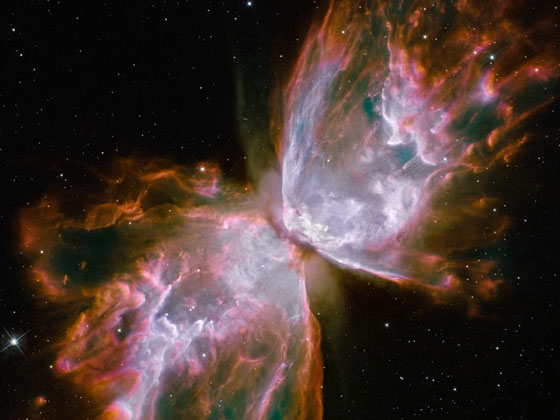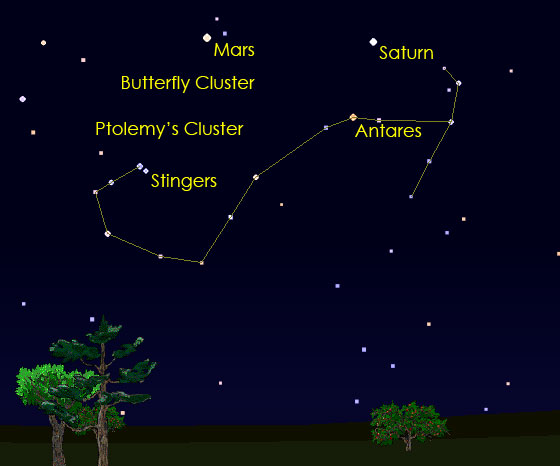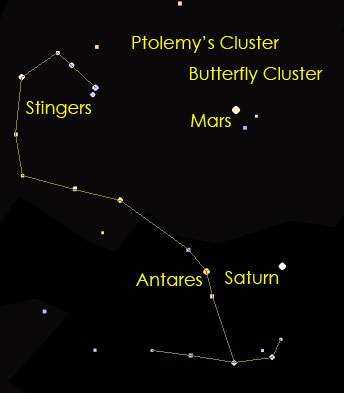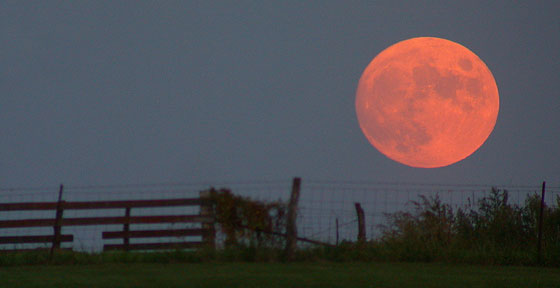
The bright clusters and nebulae of planet Earth’s night sky are often named for flowers or insects. Though its wingspan covers over 3 light-years, the Butterfly Nebula (a.k.a. NGC 6302) in the constellation Scorpius is no exception. With an estimated surface temperature of about 250,000 degrees C, the dying central star of this particular planetary nebula has become exceptionally hot, shining brightly in ultraviolet light but hidden from direct view by a dense torus of dust.
Cutting across a bright cavity of ionized gas, the dust torus surrounding the central star is near the center of this view, almost edge-on to the line-of-sight. Molecular hydrogen has been detected in the hot star’s dusty cosmic shroud. The Butterfly Nebula lies about 4,000 light-years away in the arachnologically correct constellation of the Scorpion (Scorpius).

While you need the Hubble Space Telescope to get such a spectacular view of an object like this in Scorpius, there are other neat things you can see in Scorpius with an amateur telescope or just a plain pair of binoculars.
The beautiful, ringed planet Saturn and the red planet Mars are both just to the east of the prominent, summertime constellation Scorpius. If you live in the northern hemisphere of Earth, look for Scorpius toward the south-southwest after sunset. Its brightest stars outline a large “J” in the night sky. Mars, Saturn and Scorpius’ bright, red star Antares form a triangle in the night sky.

While you need a telescope in order to get a good view of Mars and Saturn, with a simple pair of binoculars you can see two famous, open clusters of stars. Look for the two “stinger” stars at the tail end of Scorpius. Draw an imaginary line through them and extend the line eastward to Ptolemy’s Cluster (a.k.a. “M7”). M7 is about 800 light-years from Earth. In other words, the light you’ll see from this star cluster was generated 800 years ago! Just up and somewhat westward from Ptolemy’s Cluster is the Butterfly Cluster (a.k.a. “M6”), which is about 1,600 light-years from Earth. You should be able to see both M6 and M7 simultaneously through a pair of binoculars.
BTW, don’t confuse the Butterfly Cluster of star with the Butterfly Nebula. While they’re both in Scorpius, they are located in entirely different areas of the constellation.

If You’re in the Southern Hemisphere
If you’re in the southern hemisphere of Earth look for Scorpius high in the sky after sunset. The brighter stars of the constellation will form an upside-down letter “J”. Because Mars and Saturn will be much higher in the sky, you should get a better view of those two planets than observers in the northern hemisphere.
Don’t miss the Harvest Moon!

The Harvest Moon in the northern hemisphere occurs Friday, September 16. The Harvest Moon is defined as the full Moon closest to the autumnal equinox. Full Moon occurs at 3:05 pm EDT (7:05 pm GMT) September 16. So grab your scythe, get out there and harvest the crops! If nothing else, take a peek at the beautiful full Moon tonight!
Did you know you can use the Moon to find constellations in the night sky? Follow us on Twitter where we post information each day about what constellation (area of the night sky) the Moon is in that evening.
Name A Star Live offers some really good tools to learn about the night sky and find your star’s constellation. Visit our website to learn about our Virtual Planetarium software, planisphere constellation finder, and First Light Astronomy Kit!